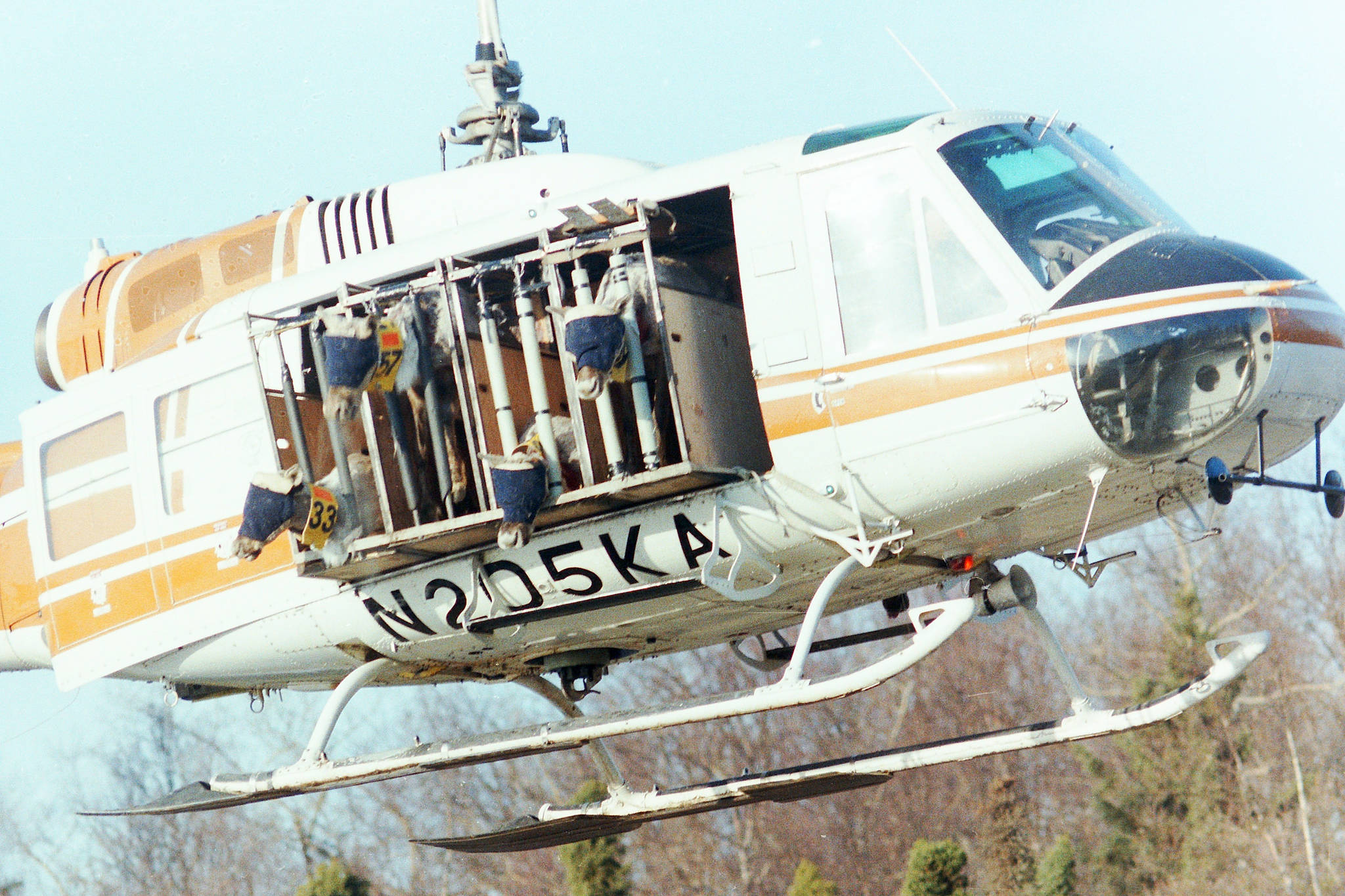By DOM WATTS
Imagine, if you will, a couple of U.S. Fish and Wildlife Service biologists in a seaplane flying over the Kenai Mountains, when they notice three mountain goats swimming across Cooper Lake, near Cooper Landing. So naturally, they landed the Grumman Widgeon, taxied up to the swimming goats, captured one, hogtied it, and loaded it into the plane with them. A few days later, they transported it over to Kodiak Island and dropped it off.
This was the third goat translocated from the Kenai to Kodiak in hopes of establishing a new population there. Using a variety of methods, including charging at goats while yelling and lassoing them, 17 goats were translocated to Kodiak during 1952–53. Goats have since flourished on the island, now occurring at some of the highest densities recorded for the species.
During the 1950s, the Kenai Peninsula also was an important source of moose for introductions in the Copper River Delta near Cordova. The population flourished and, more than 60 years after these initial efforts, moose remain a self-sustaining and viable population in this area.
Dall sheep also were translocated from the Kenai to Kodiak during the 1960s, but these attempts ultimately failed to establish a population on Kodiak.
Wildlife translocations on the Kenai are not just limited to big game, either. Ruffed grouse, for example, are actually not native to the Kenai Peninsula. The few ruffed grouse that I’ve managed to find are, in fact, descendants of 232 birds that were introduced to the Kenai during the 1990s.
Although ruffed grouse still aren’t very abundant, these efforts did successfully establish a self-sustaining population of ruffed grouse on the Kenai Peninsula.
Establishing new populations isn’t the only reason biologists translocate wildlife. Management agencies also use translocations to re-establish extirpated native wildlife populations or augment those that have been reduced to critically low numbers.
For example, mountain goats were translocated to Cecil Rhode Mountain in 1983 to augment a dwindling population that had nearly been extirpated by over-harvest. Goats were captured from other areas in the Kenai Mountains and released on Cecil Rhode Mountain to repopulate the area, where a robust goat population still persists today.
Translocations have also been used to re-establish species that were extirpated from the Kenai Peninsula. Many folks don’t know that the caribou seen grazing around Soldotna and Kenai are not actually native to the peninsula.
An abundant native caribou population, a subspecies known as Stone’s caribou, once existed on the Kenai, but was extirpated around the turn of the century. Although no one really knows the cause of their disappearance, overhunting and habitat changes from human-caused fire are thought to be key contributing factors.
Caribou were later reintroduced to the Kenai from the Nelchina herd during the 1960s. These early translocations resulted in the establishment of the Kenai Lowland and Kenai Mountains caribou herds. Later translocations of Nelchina caribou, during the 1980s, eventually established the Killey River and Fox River herds in the central Kenai Mountains. Collectively, these four herds persist on the Kenai Peninsula, allowing harvests of approximately 20 to 30 caribou annually.
Beyond deliberate introductions, it is also important to consider unintended translocations and the potential consequences of such introductions. The Kenai Peninsula is no stranger to the detrimental consequences of accidentally introduced invasive species like elodea and the green alder sawfly, which can wreak havoc on native fish and wildlife populations.
Less sinister invasions, however, may also occur as a result of human activities. Take, for example, Sitka black-tailed deer. In 1923, seven deer were translocated from Baranof Island to the Homer Spit in an attempt to introduce deer to the area. This early attempt failed, but that doesn’t necessarily mean the Kenai Peninsula will forever remain devoid of deer.
Other introductions during the 1920s and 1930s successfully established deer populations on several islands in Prince William Sound and near Cordova. Prince William Sound lies at the northern extreme of the black-tail deer’s range.
Deep snows during severe winters and a lack of old growth forests, which offer refugia from heavy snows, have largely limited the spread of black-tailed deer beyond Prince William Sound.
A warming climate and associated shifting habitats, particularly those of increasing mountain hemlock forests, suggest that black-tailed deer might eventually expand their range onto the Kenai Peninsula. Following consecutive years of mild winters, recent sightings of black-tailed deer on the mainland east of Prince William Sound, near Anchorage, and on the Kenai Peninsula itself, may be a harbinger of such an invasion in the not too distant future.
If you’re interested in learning more about wildlife translocations throughout the state, check out the Alaska Department of Fish and Game’s Technical Bulletin “Game Transplants in Alaska.” (https://www.adfg.alaska.gov/static/home/library/pdfs/wildlife/research_pdfs/game_transplants_alaska.pdf).
Dom Watts is a Wildlife Biologist at Kenai National Wildlife Refuge. Find more Refuge Notebook articles (1999-present) at https://www.fws.gov/Refuge/Kenai/community/Refuge_notebook.html.

